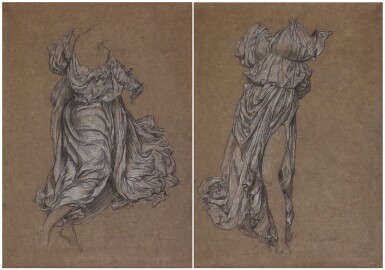
Property from an American Private Collection
Frederic, Lord Leighton, P.R.A.
Study for Terpsichore; Study for Erato
Lot Closed
July 13, 02:38 PM GMT
Estimate
20,000 - 30,000 GBP
Lot Details
Description
Property from an American Private Collection
Frederic, Lord Leighton, P.R.A.
British
1830 - 1896
Study for Terpsichore; Study for Erato
each inscribed 8 inches high lower right
black and white chalk on paper
Unframed: 52 by 36.5cm., 20½ by 14¼in.
Framed: 74 by 60cm., 29 by 23½in.
These two wonderful drawings were made in preparation for parts of a decorative scheme painted by Leighton in 1886 for the ceiling of the ‘Greek Parlor’, the music-room of Henry Marquand, the second President of the Metropolitan Museum of Art in New York. Marquand was a rail-roader, banker, Wall Street broker and real estate agent, who made a vast fortune and had an almost limitless budget for the decoration of his mansion on Madison Avenue, New York. Each room was themed; an English Renaissance dining room hung with late sixteenth-century tapestries, a Japanese room for Marquand’s collection of Asian art and a smoking room in Moroccan style. In 1884 Marquand commissioned Lawrence Alma-Tadema to decorate his music room in a classical style, telling the artist that money was no object for this room. Tadema designed a striking suite of twenty-nine pieces of furniture in sandalwood with inlays of ivory, mother-of-pearl and ebony, the centre-piece being a magnificent piano (Sotheby’s Parke Bernet, New York, 26 March 1980, lot 535). The lid was inlaid with the names of Apollo and the nine Muses and this probably dictated the choice of subject for Leighton’s ceiling, which was commissioned to be installed directly above the instrument. In August 1884 Tadema wrote to Marquand about the project; ‘At last I can give you some decided news about the ceiling. Sir Frederic [sic] Leighton proposes to paint for you on a gold ground or silver if you chose, 7 life-size figures, 3 in the big panel [sic] and 2 in each of the smaller ones. The distance being small. The spectator seeing everything clearly. Those figures will have to be carefully executed as he only can do it and he will squeeze your order in for next summer. He will undertake to do it for the sum of £2,000.’ (letter among the Marquand Papers, Princeton University) As promised Leighton began preparatory work on the ceiling in 1885 and by 17 May 1886 he could report on his design for the tripartite decoration in a letter to Marquand; ‘I am at present closely engaged on it – my friends seem to admire the design and I am bent on sending to your country, and the more gladly that it is for so true a lover of art, a specimen of the very best I can do… I have thought that is a room dedicated to the performance of music the muses with [be] the proper presiding spirits in as much as with the Greeks music & poetry always went hand in hand. In the central compartment therefore I have introduced two of them; Melpomene and Thalia, the muses of sacred and epic poetry. Seated between them is Mnemosyne, the mother of the Muses, above whom hover two wandering genii winged voices of melody and song. On each side of her are the Delphic emblems, the tripod, Pytheus, the laurel and at her feet the Dolphin.’ (letter in the collection of the Library of the Metropolitan Museum of Art in New York) The ceiling decoration was painted on three canvases in Leighton’s London studio and were photographed in an incomplete state with the figures undraped. It was Leighton’s usual practice to paint figures in the nude on his canvases and to drape them afterwards to ensure anatomical exactness. The detail of the drapery folds in the two present drawings demonstrates how important he regarded the fall of cloth on his models’ bodies. From these drawings Leighton would have ‘clothed’ the naked figures already painted on his canvases.
The figures of Erato (Muse of Lyric Poetry) and Terpsichore (Muse of Dance), occupied the two side panels. The three canvases were completed in time to be exhibited at the summer exhibition at the Royal Academy in 1886 where Tadema described them in a letter to Marquand as ‘one of the happiest things Leighton has ever put together’. They were installed in the Autumn of 1886 and these gilded panels graced the ceiling of the New York mansion for four decades. The panels are now dispersed, Erato (Sotheby’s, New York, 28 January 2021, lot 45) and Terpsichore (Sotheby’s, New York, 29 October 1987, part of lot 185)) being in their original state, whilst the central canvas has been divided into three.
You May Also Like










